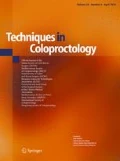Abstract
Background
Levator ani syndrome (LAS) is a functional disorder that can be a challenge to treat. LAS that is refractory to medical management may be treated with electrogalvanic stimulation (EGS) or Botulinum toxin A (BTX) injection. The aim of the present study was to evaluate the outcomes associated with both EGS and BTX in patients with medically refectory LAS to determine if either demonstrate a long-term benefit or whether one treatment is better than the other.
Methods
A retrospective study was performed on consecutive patients with LAS treated with BTX or EGS at our institute. Patients were identified from a prospectively maintained database. The study time frame was 6 years.
Results
One hundred and twenty patients [80 females, mean age 52 years (range 21–84, SD 15.8)] were treated for medically refractory LAS: 102 with BTX and 18 with EGS. With EGS, 28.6% of patients reported a complete response, 14.3% reported a partial response and 57.1% reported no response to treatment. With BTX, 35.5% of patients reported a complete response, 19.7% reported a partial response and 44.7% reported no response to treatment. There was no difference between BTX and EGS with regard to treatment response. Patients who had BTX were more likely to report a short-term benefit in treatment when compared to those patients who had EGS (p = 0.002). This difference between reported outcome to BTX and EGS treatments did not sustain in the long term (p = 0.2).
Conclusions
Both BTX and EGS are to some extent effective at resolving symptoms of LAS. In the short term, BTX appears to be more effective. Neither treatment sustains its benefit in the long term.


Similar content being viewed by others
References
Ger GC, Wexner SD, Jorge JM et al (1993) Evaluation and treatment of chronic intractable rectal pain—a frustrating endeavor. Dis Colon Rectum 36:139–145
Bharucha AE, Wald A, Enck P, Rao S (2006) Functional anorectal disorders. Gastroenterology 130(5):1510–1518
Bordeianou LG, Carmichael JC, Paquette IM et al (2018) Consensus statement of definitions for anorectal physiology testing and pelvic floor terminology (Revised). Dis Colon Rectum 61(4):421–427
Purwar B, Khuller V (2016) Uses of botulinum toxin for chronic pelvic pain. Women’s Health (Lond). 12(3):293–296
Grant SR, Salvati EP, Rubin RJ (1975) Levator syndrome: an analysis of 316 cases. Dis Colon Rectum 18:161–163
Dodi G, Bogoni F, Infantino A et al (1986) Hot or cold in anal pain? A study of the changes in internal anal sphincter pressures profiles. Dis Colon Rectum 29:248–251
Kang YS, Jeong SY, Cho HJ, Kim DS, Lee DH, Kim TS (2000) Transanally injected triamcinolone acetonide in levator syndrome. Dis Colon Rectum 43(9):1288–1291
Grimaud JC, Bouvier M, Naudy B, Guien C, Salducci J (1991) Manometric and radiologic investigations and biofeedback treatment of chronic idiopathic anal pain. Dis Colon Rectum 34(8):690–695
Pontari MA, Krieger JN, Litwin MS et al (2010) Pregabalin for the treatment of men with chronic prostatitis/chronic pelvic pain syndrome: a randomized controlled trial. Arch Int Med. 170(17):1586–1593
Whitehead WE, Wald A, Diamant NE, Enck P, Pemberton JH, Rao SS (1999) Functional disorders of the anus and rectum. Gut. 45(Suppl 2):II55–II59 (review)
Bolshinsky V, Gurland B, Hull TL, Zutshi M (2018) Levator ani syndrome: transperineal Botox injections. Tech Coloproct 22:465–466
Hawkins AT, Bordeianou L, Hawkins AT, Bordeianou L (2016) Chronic anal pain. Anorectal disease. Springer, Cham, pp 243–262
Sohn N, Weinstein MA, Robbins RD (1982) The levator syndrome and its treatment with high-voltage electrogalvanic stimulation. Am J Surg 144(5):580–582
Drossman DA (2016) Functional Gastrointestinal disorders: history, pathophysiology, clinical features and Rome IV. Gastroenterology 150:1262–1279
Hull TL, Milsom JW, Church J, Oaskley J, Lavery I, Fazio V (1993) Electrogalvanic stimulation for levator syndrome: how effective is it in the long term? Dis Colon Rectum 36:731–733
Park DH, Yoon SG, Kim KM, Hwang DY, Kim HS, Lee JK, Kim KY (2005) Comparison study between electrogalvanic stimulation and local injection therapy in levator ani syndrome. Int J Colorect Dis 20:272–276
Chiarioni G, Nardo A, Vantini I, Romito A, Whitehead WE (2010) Biofeedback is superior to electrogalvanic stimulation and massage for treatment of levator ani syndrome. Gastroenterology 138(4):1321–1329
Bibi S, Zutshi M, Gurland B, Hull T (2016) Is Botox for anal pain an effective treatment option? Postgrad Med 128(1):41–45
Rao SS, Paulson J, Mata M, Zimmerman B (2009) Clinical trial: effects of botulinum toxin on Levator ani syndrome—a double-blind, placebo-controlled study. Aliment Pharmacol Ther 29(9):985–991
Ooijevaar RE, Felt‑Bersma RJF, Han‑Geurts IJ, van Reijn D, Vollebregt PF, Molenaar CBH (2019) Botox treatment in patients with chronic functional anorectal pain: experiences of a tertiary referral proctology clinic. Tech Coloproctol (epub ahead of print)
Gosselink MJ, Schouten WR (2001) Rectal sensory perception in females with obstructed defecation. Dis Colon Rectum 44:1337–1344
Drossman DA, Li Z, Andruzzi E, Temple R et al (1993) U.S. householder survey of functional gastrointestinal disorders: prevalence, sociodemography and health impact. Dig Dis Sci 38:1569–1580
Funding
No grant support or financial relationships to declare.
Author information
Authors and Affiliations
Contributions
EN: design, data collection, data analysis, manuscript writing. MB: data collection, data analysis, manuscript writing. SG: data collection, data analysis, manuscript writing. MZ: design, data analysis, manuscript editing.
Corresponding author
Ethics declarations
Conflict of interest
The authors declare that there is no competing interest.
Ethical approval
All procedures were in accordance with the ethical standards of the responsible committee on human experimentation (institutional and national) and with the Helsinki Declaration of 1975, as revised in 2000.
Informed consent
This was not required as per our Institutional Review Board.
Additional information
Publisher's Note
Springer Nature remains neutral with regard to jurisdictional claims in published maps and institutional affiliations.
Rights and permissions
About this article
Cite this article
Nugent, E., Beal, M., Sun, G. et al. Botulinum toxin A versus electrogalvanic stimulation for levator ani syndrome: is one a more effective therapy?. Tech Coloproctol 24, 545–551 (2020). https://doi.org/10.1007/s10151-019-02103-w
Received:
Accepted:
Published:
Issue Date:
DOI: https://doi.org/10.1007/s10151-019-02103-w




